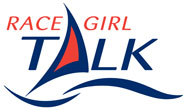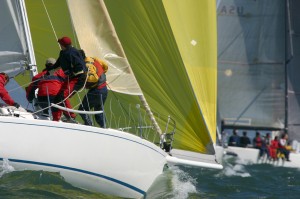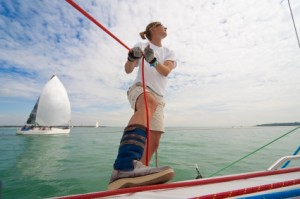Sailboat Racing Trim — Part 9
In Chapter 9 of his book Racing Trim, Bill Gladstone talks about downwind boat handling. The following post shows a short summary of that chapter.
Spinnaker Sets
- Pre-Rig — Plan everything for the spinnaker before the race starts. Run the spinnaker tapes, connect the halyard, and sheets (or sheet and guy), and pre-rig the downhaul and topping lift on the pole.
- Set Up — Know whether you will hoist the spinnaker from the hatch or the leeward rail.
- Pole Up — Stay on the rail as long as possible (hoisting the topping lift can be done from the rail with some crew coordination).
- Hoist — Be ready to hoist at the mark, but stay on the rail until the hoist is called for.
- Bear Away Set — Pre-feed the guy to the end of the pole as the boat approaches the mark (the boat is close hauled). Bear away (to a reach), and hoist the spinnaker. Make sure that the spinnaker is fully hoisted before it is trimmed.
- Jibe Set — Use this when the spinnaker set is on the opposite tack as the rounding. The pole can not be raised until the jib has been jibed. Gladstone goes through a sample jibe set plan with seven crew members in his book.
- Tack Set — The pole can’t be set before the rounding. Raise the pole as soon as the spinnaker is hoisted.
- Driving — The driver should turn the boat from broad reach to broad reach. Don’t hold the boat dead downwind. Watch your head and call to others as the boom comes across the cockpit.
- Trimming — Trim so that the spinnaker stays full and rotates continuously around the boat (balance trimming the sheet with easing the guy).
- Blame — The speed of the driver’s turn needs to match the speed of the trimmers. If not, the spinnaker will collapse. Gladstone periodically pokes fun at the skipper and the crew throughout the book. This section is an example : )
- Over Rotate — In order to keep the spinnaker full while jibing, over rotate it.
- End for End Jibes — typically used on smaller boats with lighter poles. It can be a bit quicker than dip pole jibes.
- Dip Poles Jibes — Used when the pole is too big or heavy to be jibed end for end.
- Heavy Air — You can get by with less rotation in heavy air.
- Light Air — You may want to drop the lazy guys (if you use them) to reduce weight pulling the sail down.
- Special Conditions
- Reach to Reach — This will take really aggressive trimming. The driver can help by matching speed of the turn.
- Light Air — Run the sail around through the turn; and pause the turn slightly by the lee.
- Heavy Air — Use the twings to choke down the spinnaker and watch out for broaches. Make sure the sails don’t overwhelm the rudder. Be ready to blow the vang (and sheet if necessary).
- Stretch & Blow — Hoist the jib, ease the spinnaker pole to the forestay and over trim the spin sheet to stretch the spinnaker. Turn the boat so that the spinnaker collapses, and blow the halyard. Finish lowering the pole.
- Pole Down, Chute Down — Hoist the jib. Trip and drop the pole. Clear the topping lift, if there’s time. Free fly the spinnaker until just before the mark. Drop the spinnaker and go hike out. Clean up the gear after the boat is up to speed.
This is the ninth in a series of posts based on Bill Gladstone’s book Racing TRIM from the North U. Series. Periodically, I post about a chapter or two. This will be my short summary of what I’ve read. You can read the posts to get my abbreviated summary; or you could read through the books with me. Your comments can help point out what you find most interesting, or even poke fun at what I do and don’t know. If you are interested in getting this book, you can find it in the online store section of NorthU.com for $25.



